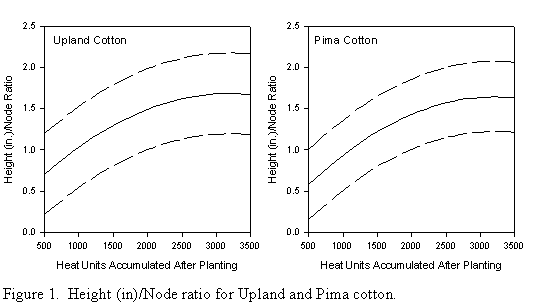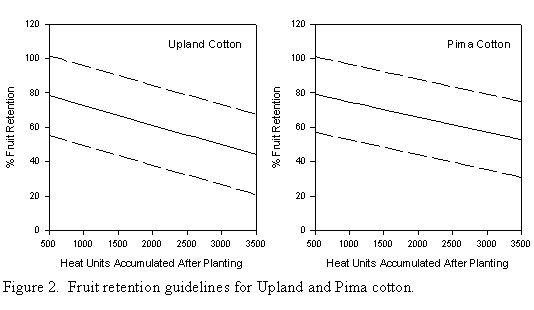Mepiquat Chloride (MC) Application Guidelines for Arizona Cotton
(Publication az1211)
(PDF file version, 47KB)
by Jeffrey C. Silvertooth,
Extension Agronomist - Cotton
MC APPLICATIONS - DECISION BASE
Follow Fruit Retention (FR) and Height:Node Ratios (HNR) vs. Heat Units After Planting (HUAP)
- Reference: HNR & FR baselines with upper and lower thresholds,
Figures 1 & 2 (J.C. Silvertooth
et al. UA)
IF HNRs are trending toward, equal, or exceed upper HNR thresholds (Fig. 1)
- vegetative tendancies are very likely
- evaluate fruit retention (FR) levels also, (see Figure 2)
- should confirm vegetative condition
- consider initiation of MC treatments
- follow rate guidelines (see Table below)
- follow crop response (HNRs)
IF HNRs are near the baseline (middle line on figures)- plant height (vegetative) control is not a problem
- withold MC applications
IF HNRs are near lower HNR threshold- crop may have been under some degree of stress
- evaluate crop for possible causes of reduced vegetative structure
- withold MC applications
- vegetative tendancies are very likely
Continue to monitor field development on a regular basis: follow HNR and FR conditions in relation to baselines
Table 1. Suggested Mepiquat Chloride (MC) application rates*
|
Minimum |
0.5 pt./acre |
|
Maximum |
1.5 pt./acre |
|
General Optimum |
0.75 pt./acre |
*Based on University of Arizona research (J.C. Silvertooth, et al.)
Issued in furtherance of Cooperative Extension work, acts of May 8 and June 30, 1914, in cooperation with the U.S. Department of Agriculture, James A. Christenson, Director Cooperative Extension, College of Agriculture and Life Sciences, The University of Arizona.
The University of Arizona is an equal opportunity, affirmative action institution. The University does not discriminate on the basis of race, color, religion, sex, national origin, age, disability, veteran status, or sexual orientation in its programs and activities.
Any products, services, or organizations that are
mentioned, shown, or indirectly implied in this web document do not imply
endorsement by The University of Arizona.
Information provided by Jeffrey C. Silvertooth, silver@ag.arizona.edu
Extension Agronomist - Cotton, College of Agriculture, The University of Arizona.
Material written June 2001.
Crop Mgmt | Soil Mgmt | Irrigation | Varieties | Cotton Comments
Home | Cotton | Advisories
document located at: http://cals.arizona.edu/crops/cotton/cropmgt/pix_application.html
Copyright © 2001 University of Arizona,
College of Agriculture and Life Sciences
Webmaster: Al Fournier (acis@ag.arizona.edu)

